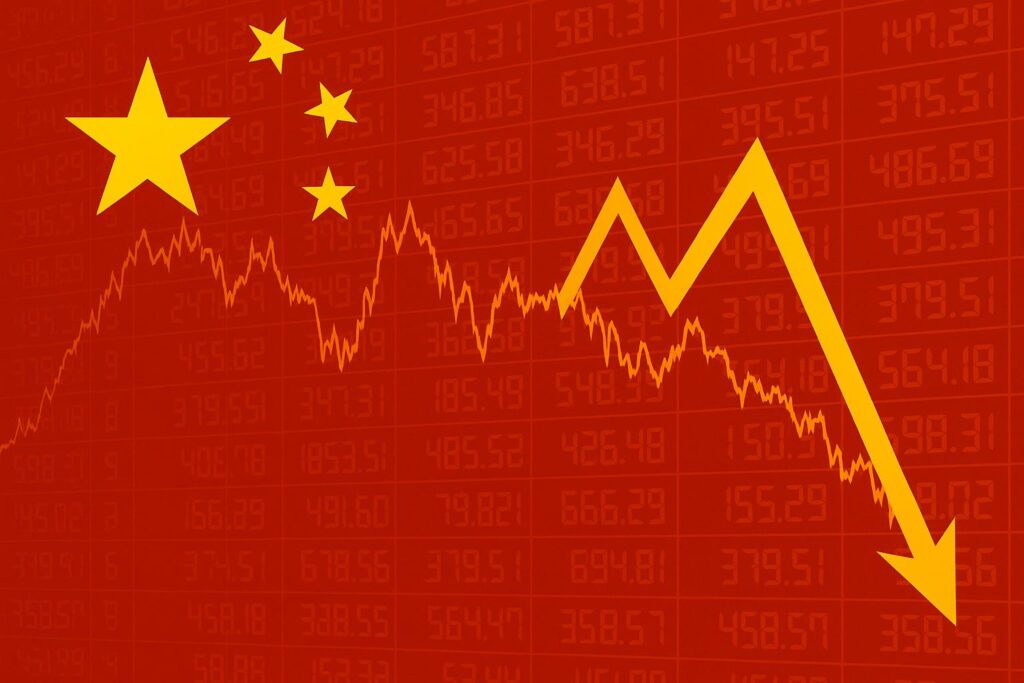Last month marked the collapse of China’s Evergrande, once the world’s most indebted developer with $300 billion in liabilities. The real estate sector remains a debt bubble, fueled by roughly $695 billion in new government-approved loans.
While the property crisis has been widely reported, the broader scale of China’s debt problem is less understood. Official figures show that public and private debt combined already exceed 309% of GDP, yet even this number understates the true scope.
When other sources of leverage are factored in, such as margin trading, shadow banking through wealth management products, and off-balance-sheet local government borrowing, China’s total debt burden climbs to at least 400 percent of GDP.
China’s long-anticipated post-pandemic rebound never arrived. Instead, 2024 exposed deep structural weaknesses and a government unwilling to enact meaningful reforms. The Third Plenum, the central government’s economic planning session, passed without major policy shifts, leaving the economy weighed down by debt, a faltering property sector, weak consumption, and a constrained private sector.
Household consumption has also failed to recover. Retail sales remain well below pre-pandemic trends, as falling property values create a negative wealth effect. High unemployment, especially among the young, has further dampened spending.
The most visible problem is real estate. Years of overbuilding left millions of unsold apartments and developers like Evergrande collapsing under impossible debts. Housing sales have fallen below 2017 levels, and government rescue schemes, such as buying up vacant units, are far too small to stabilize the market.
All of these pressures have fueled China’s mounting debt bubble. By mid-2025, total social financing, the broadest measure of combined debt, had reached about $59 trillion, equal to 309% of GDP.
Ironically, stock market trading is adding to this massive debt. As investors retreat from real estate, capital is shifting into the stock market. But much of this trading is being fueled by margin trading, borrowed money. By September 2025, margin debt had reached a record $320 billion. Importantly, this debt is excluded from the official composite debt-to-GDP figure, leaving China’s true leverage even higher than reported.
While Beijing’s control over the financial system reduces the risk of a classic banking crisis, the real danger lies in unrecognized losses buried across balance sheets. For more than a decade, growth targets forced local governments and state-linked entities to pour money into property, infrastructure, and industry regardless of profitability. Instead of being written down, failed investments were carried at full value, inflating GDP and asset values while masking the true scale of economic losses. The result is trillions in fictitious assets and a mounting debt load that cannot be serviced by the returns they generate.
Another major source of hidden debt is shadow banking, where off-balance-sheet wealth management products alone total an estimated $8–12 trillion USD. Local governments add further to the burden through financing vehicles (LGFVs), companies created to bypass borrowing restrictions and raise money for infrastructure projects. These liabilities are often kept off official balance sheets, recorded as corporate debt rather than government obligations.
While some LGFV borrowing, such as bonds explicitly guaranteed by the state, appears in official statistics, large portions backed by implicit guarantees or other quasi-fiscal arrangements are excluded from the 309% debt-to-GDP ratio.
Local governments have come to depend on these vehicles to fund projects far beyond their budgets, and the weight of accumulated debt is becoming harder to ignore. Provinces are now cutting services and even delaying salaries, while the collapse of land-sale revenues has made repayment increasingly difficult. By Q3 2024, local government debt stood at roughly $17.2 trillion, including $10.7 trillion in hidden LGFV obligations.
Hidden LGFV debt has more than tripled in the past five years, and now accounts for roughly 16 percent of bank assets. And the payments are coming due. Most listed LGFV obligations mature within five to seven years, with about $348 billion USD in bonds due over the next twelve months alone.
China’s banking sector now has greater exposure to LGFVs than to the housing market. Beijing is expected to step in to cover some of these loans to prevent a banking crisis, but such intervention only reinforces moral hazard and delays the recognition of losses, leaving banks vulnerable if the economy fails to recover.
Beijing has launched a $1.4 trillion initiative that includes a debt swap program allowing local governments to exchange short-term LGFV liabilities for longer-term, lower-cost bonds. The central bank has also unveiled an even broader plan to tackle hidden local debt through 2026. Yet shifting liabilities from local to central balance sheets does nothing to resolve the deeper problem of excessive and often unproductive borrowing.
Read the full article here
